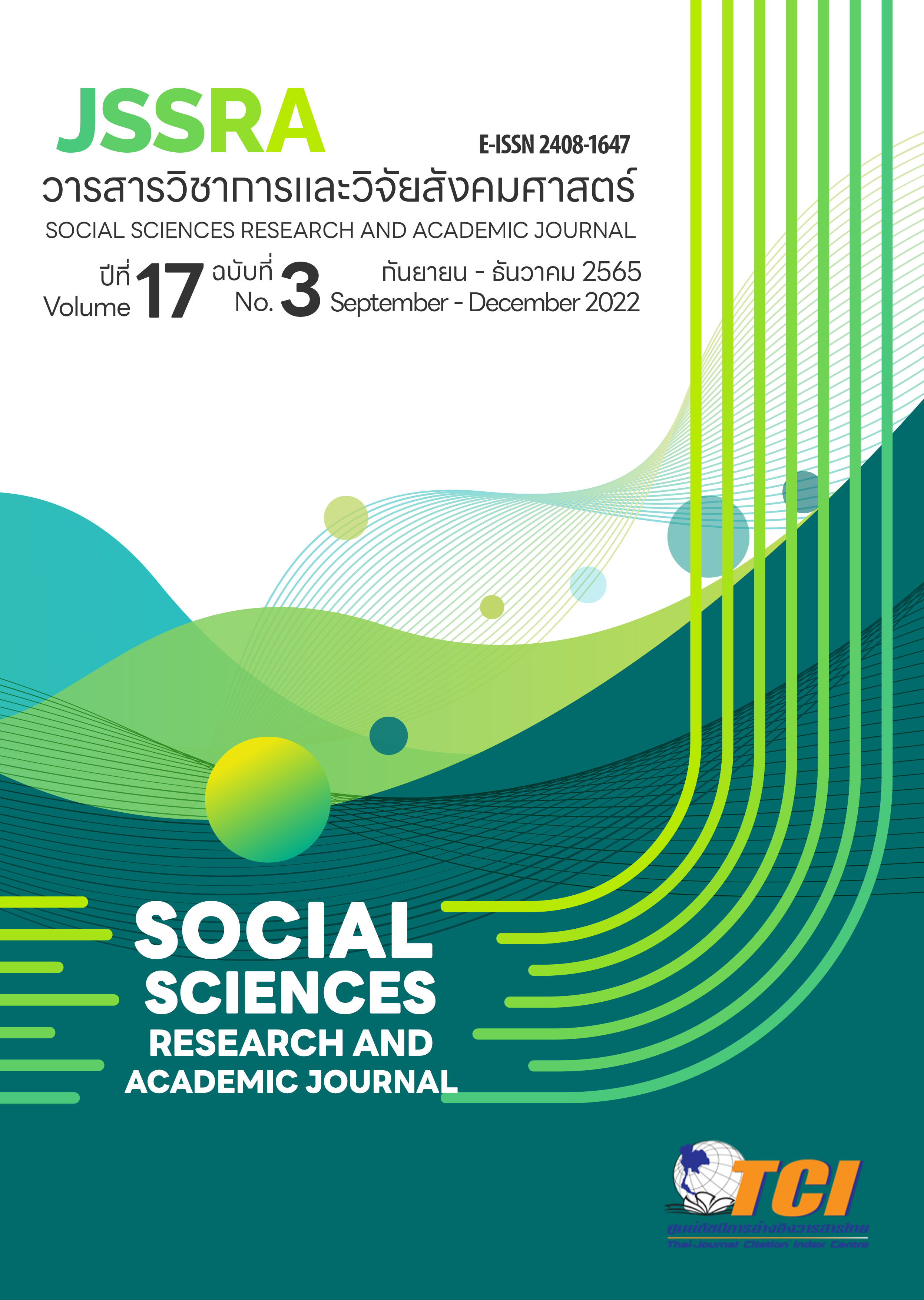การพัฒนาหลักสูตรบูรณาการตามแนวคิดสะเต็มศึกษาและทฤษฎีการสร้างสรรค์ด้วยปัญญา เพื่อเสริมสร้างทักษะการเรียนรู้และนวัตกรรมของนักเรียน สำหรับนักเรียนชั้นประถมศึกษาปีที่ 6 The Development of Integrated Curriculum Based on STEM Education and Constructionism Theory to Enhance Students’ Learning and Innovation Skills for Prathomsuksa 6 Students
Main Article Content
บทคัดย่อ
การวิจัยครั้งนี้มีจุดมุ่งหมายเพื่อ 1) ศึกษาองค์ประกอบและตัวชี้วัดของทักษะการเรียนรู้และนวัตกรรมของนักเรียน 2) พัฒนาหลักสูตรบูรณาการตามแนวคิดสะเต็มศึกษาและทฤษฎีการสร้างสรรค์ด้วยปัญญา เพื่อเสริมสร้างทักษะการเรียนรู้และนวัตกรรมของนักเรียน สำหรับนักเรียนชั้นประถมศึกษาปีที่ 6 และ 3) ศึกษาผลการทดลองใช้หลักสูตรบูรณาการที่พัฒนาขึ้น กลุ่มตัวอย่าง คือ นักเรียนชั้นประถมศึกษาปีที่ 6 โรงเรียนบ้านนานอ ปีการศึกษา 2563 จำนวน 13 คน ได้มาจากการสุ่มตัวอย่างแบบแบ่งกลุ่ม เครื่องมือที่ใช้ในการวิจัย ประกอบด้วย หลักสูตรบูรณาการ แผนการจัดการเรียนรู้ แบบทดสอบวัดทักษะการเรียนรู้และนวัตกรรม แบบทดสอบวัดผลสัมฤทธิ์ทางการเรียน และแบบสอบถามความพึงพอใจ สถิติที่ใช้ในการวิเคราะห์ข้อมูล ได้แก่ ร้อยละ ค่าเฉลี่ย ส่วนเบี่ยงเบนมาตรฐาน การทดสอบค่าทีชนิดกลุ่มไม่อิสระกัน และการทดสอบค่าทีชนิดกลุ่มเดียวเทียบกับเกณฑ์
ผลการวิจัยพบว่า 1) ทักษะการเรียนรู้และนวัตกรรมของนักเรียน มี 3 องค์ประกอบ 14 ตัวชี้วัด มีคะแนนคุณภาพเฉลี่ยเท่ากับ 4.77 อยู่ในระดับมากที่สุด 2)หลักสูตรบูรณาการที่พัฒนาขึ้น มี 10 องค์ประกอบ คะแนนคุณภาพเฉลี่ยเท่ากับ 4.85 อยู่ในระดับมากที่สุด และ 3) ผลการทดลองใช้หลักสูตรบูรณาการที่พัฒนาขึ้น พบว่า (1) ทักษะการเรียนรู้และนวัตกรรมของนักเรียนหลังเรียนสูงกว่าก่อนเรียนและสูงกว่าเกณฑ์ที่ตั้งไว้ที่ร้อยละ 70 อย่างมีนัยสำคัญทางสถิติที่ระดับ .01 (2) ผลสัมฤทธิ์ทางการเรียนของนักเรียนหลังเรียนสูงกว่าก่อนเรียนและสูงกว่าเกณฑ์ที่ตั้งไว้ที่ร้อยละ 70 อย่างมีนัยสำคัญทางสถิติที่ระดับ .01 และ (3) นักเรียนมีความพึงพอใจต่อการจัดกิจกรรมการเรียนรู้ตามหลักสูตรบูรณาการที่พัฒนาขึ้นอยู่ในระดับมากที่สุด
The purposes of this research were: 1) to study the components and indicators of students’ learning and innovation skills, 2) to develop an integrated curriculum based on STEM education and constructionism theory to enhance students’ learning and innovation skills for Prathomsuksa 6 students, and 3) to study the effects after the integrated curriculum implementation. The sample consisted of 13 students in Prathomsuksa 6, Ban Na Nor School, of the academic year 2020, obtained through cluster random sampling. The research instruments consisted of an integrated curriculum, a learning management plan, a learning and innovation skills test, an achievement test, and a set of satisfaction questionnaires. Statistics for data analysis included mean, percentage, standard deviation, dependent samples t-test, and one-sample t-test.
The findings were as follows: 1) Students’ learning and innovation skills consisted of 3 components with 14 indicators has an average score of 4.77 (Highest). 2) The developed integrated curriculum consisted of 10 components has an average score of 4.85 (Highest). And 3) the effects after the integrated curriculum implementation revealed that: (1) Students’ learning and innovation skills after the integrated curriculum implementation was higher than that of before intervention and the preset criteria of 70 percent at the .01 level of significance. (2) Students’ achievements after the integrated curriculum implementation were higher than that of before intervention and the preset criteria of 70 percent at the .01 level of significance. And (3) the students’ satisfaction toward the activities management according to the integrated curriculum was at the highest level.
Article Details
เอกสารอ้างอิง
กองบริหารงานวิจัยและประกันคุณภาพการศึกษา. (2560). พิมพ์เขียว Thailand 4.0 โมเดลขับเคลื่อนประเทศไทยสู่ความ มั่งคั่ง มั่นคง และยั่งยืน. สืบค้นเมื่อ 1 พฤศจิกายน 2562, จาก https://www.nstda.or.th/home/knowledge_post/blueprint-thailand-4/.
จุลมณี สุรโยทิน. (2562). การพัฒนาหลักสูตรบูรณาการเพื่อเสริมสร้างความสามารถในการสร้างสรรค์และนวัตกรรมของนักเรียนชั้นมัธยมศึกษาตอนปลาย. วารสารราชพฤกษ์, 17(3), 43-51.
ทิศนา แขมมณี. (2552). ศาสตร์การสอน องค์ความรู้เพื่อการจัดการเรียนรู้ที่มีประสิทธิภาพ. (พิมพ์ครั้งที่ 11). กรุงเทพฯ: โรงพิมพ์แห่งจุฬาลงกรณ์มหาวิทยาลัย.
ประทีป คงเจริญ. (2564). ทักษะการเรียนรู้และนวัตกรรม: คุณลักษณะสำคัญของพลโลกในยุคเศรษฐกิจที่ขับเคลื่อนด้วยนวัตกรรม. วารสารมนุษยศาสตร์และสังคมศาสตร์มหาวิทยาลัยธนบุรี, 15(3), 165-177.
บุญชม ศรีสะอาด. (2546). การพัฒนาหลักสูตรและการวิจัยเกี่ยวกับหลักสูตร. กรุงเทพฯ: สุวีริยาสาส์น.
บุญชม ศรีสะอาด. (2553). การวิจัยสำหรับครู. (พิมพ์ครั้งที่ 3). กรุงเทพฯ: สุวีริยาสาส์น.
พรทิพย์ ศิริภัทราชัย. (2556). STEM Education กับการพัฒนาทักษะในศตวรรษที่ 21. วารสารนักบริหาร, 33(2): 49-56.
โรจนฤทธิ์ จันนุ่ม. (2560). การพัฒนารูปแบบการจัดการเรียนรู้คอมพิวเตอร์ โดยใช้ทฤษฎีคอนสตรัคชันนิสซึม เพื่อเสริมสร้างความคิดสร้างสรรค์ สำหรับนักเรียนชั้นประถมศึกษาปีที่ 4. สักทอง : วารสารมนุษยศาสตร์และสังคมศาสตร์ (สทมส), 23(2), 104-119.
สงัด อุทรานันท์. (2532). พื้นฐานและหลักการพัฒนาหลักสูตร. กรุงเทพฯ: โรงพิมพ์จุฬาลงกรณ์มหาวิทยาลัย.
สถาบันทดสอบทางการศึกษาแห่งชาติ (องค์กรมหาชน). (2560-2562). รายงานผลการทดสอบทางการศึกษาระดับชาติขั้นพื้นฐาน (O-NET) ปีการศึกษา 2560-2562. สืบค้นเมื่อ 10 พฤศจิกายน 2562, จาก http://www.niets.or.th/.
สำราญ กำจัดภัย. (2560). สถิติเพื่อการวิจัยทางหลักสูตรและการสอน. สกลนคร: คณะครุศาสตร์มหาวิทยาลัยราชภัฏสกลนคร.
สุวิทย์ มูลคำ และอรทัย มูลคำ. (2545). 21 วิธีจัดการเรียนรู้เพื่อพัฒนาระบบความคิด. กรุงเทพฯ: ภาพพิมพ์.
Alexandra, E.A. (2004). The Effect of Constructionism Learning in the Social Subject on Student Achievement and Analysis Thinking. Dissertation Abstracts International. 51 (November).
Battelle for Kids. (2019). Partnership for 21st Century Learning A Network of Battelle for Kids: Framework for 21st Century Learning Definitions. Retrieved November 20, 2021, from https://static.battelleforkids.org/documents/p21/P21_Framework_DefinitionsBFK.pdf
Partnership for 21st Century Skills. (2009). 21st Century Support Systems. [Online]. Retrieved November 20, 2019, from: http://www.21stcenturyskills.org/route21/index.
Perkins, K. (1997). ESL Reading Comprehension Instruction. RELC Journal 21, 79-92.


